For the last decade, Tennessee – like other states – has taken aggressive steps to combat an evolving opioid epidemic and launched new initiatives to address the mental health care needs of K-12 students. Yet, challenges remain. To help policymakers decide how to use new federal funding for behavioral health, this report examines recent data on mental health and substance use in Tennessee leading up to and during the COVID-19 pandemic.
Key Takeaways
- Many metrics of behavioral health in Tennessee – especially drug overdose deaths – were moving in the wrong direction when the COVID-19 pandemic began.
- The pandemic has exacerbated mental health needs and substance abuse in Tennessee while limiting access to care.
- Tennessee has access to $52 million in new federal funding to spend on behavioral health. The state could also tap billions of dollars in flexible federal aid and surplus state revenue.
- Deciding how best to allocate new funding will require a careful consideration of both Tennesseans’ needs and the state’s current capacity for prevention and treatment.
New Funding Available
The American Rescue Plan – the largest of six federal funding packages passed since the COVID-19 pandemic began – committed billions of additional dollars to behavioral health. Tennessee will get $52 million in new, targeted behavioral health funding to use through September 2025 plus billions of dollars in flexible aid that policymakers could put toward similar purposes. (1) The total includes:
- $27 million in supplemental funds for the Community Mental Health Block Grant – on top of Tennessee’s regular $58 million FY 2021 allotment. (2)(3)
- $25 million in supplemental funds for the Substance Abuse Prevention and Treatment Block Grant – in addition to the state’s regular $81 million FY 2021 award. (4) (3)
- $3.7 billion in state Fiscal Recovery Funds. Behavioral health needs exacerbated by the pandemic are among the permissible uses. To date, Tennessee has not allocated any of this money toward that purpose. (5) (6)
Tennessee also has at least a $2.1 billion budget surplus from the last fiscal year and is already ahead of projections for the current year by over $900 million. The FY 2021 surplus are one-time dollars that Gov. Lee and lawmakers can use as they see fit. They could also increase the FY 2022 recurring budget based on faster-than-expected growth in these early months of the fiscal year.
The balance of this report provides context for policymakers deciding how best to allocate these funds. It provides a high-level picture of the state of behavioral health among all Tennesseans and is not a review of any specific state policies or programs to address behavioral health. Prior reports, however, provide some additional information on funding increases for behavioral health and efforts to curb the state’s opioid epidemic.
Behavioral Health in Brief
Adults Before the Pandemic
Nearly every measure of substance abuse and mental health among adult Tennesseans worsened in the five years before the COVID-19 pandemic (Figure 1). While use of many illicit drugs became less common, the most lethal drugs grew even more common. This shift drove the starkest trend: a 50% increase in the overdose death rate between 2015 and 2019. Meanwhile, heavy drinking, alcohol-related deaths, and depression all rose significantly over this period. (9) (7) (8)
Adults in Tennessee fare better than those nationwide across most measures of behavioral health, except for the most dire outcome – mortality (Figure 1). Our rates of mental illness, suicidal ideation, drug use, and drinking are all better than most states’. However, we are more likely to die from these things than the typical American. (7) (8) (9)
Figure 1
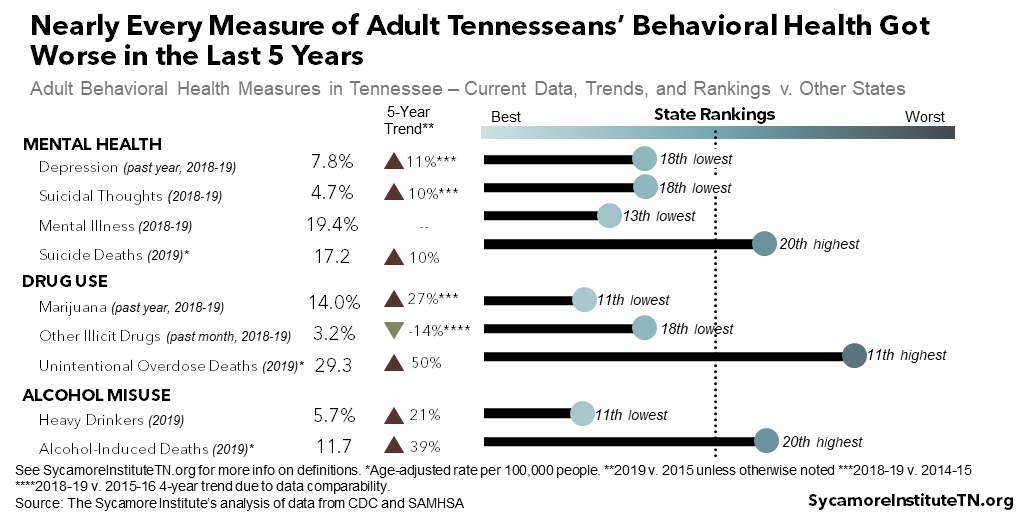
Teens & Young Adults Before the Pandemic
Many mental health metrics for younger Tennesseans worsened leading up to the pandemic, but substance abuse has fallen across the board (Figure 2). Use of alcohol declined precipitously for over a decade, and the use of substances like heroin and methamphetamine are below recent peaks. Feelings of sadness, thoughts of suicide, suicide attempts, and suicide deaths, however, were all at historically high levels going into the pandemic. (7) (10) (8)
Tennessee teens and young adults tended to have worse mental health than their peers before the pandemic, while drug and alcohol use varied by substance (Figure 2). Tennessee was among the bottom half of states with available data for measures related to suicide and chronic feelings of sadness. Our high-schoolers were more likely to have tried heroin and methamphetamine but less likely to have tried prescription drugs, use marijuana, or drink. (7) (10) (8)
Figure 2
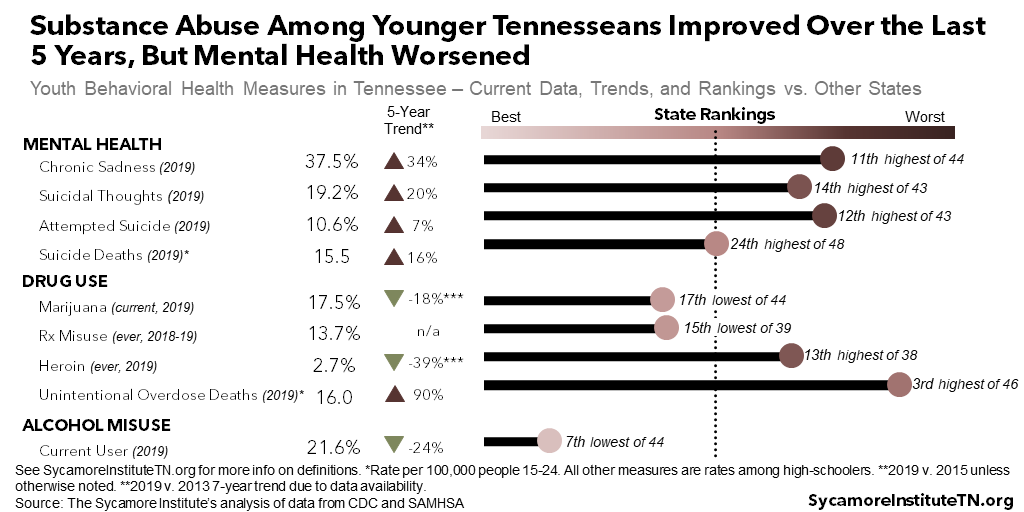
Impact of COVID
Available data and early studies suggest the COVID-19 pandemic has exacerbated mental health needs and substance abuse in Tennessee and nationwide. A majority of Tennessee adults experienced symptoms of depression and anxiety at some point in the last 18 months. Meanwhile, drug overdose deaths have surged, and it appears that more people consumed more alcohol more often than perhaps ever before. At the same time, the necessities and strains of the pandemic have often limited access to behavioral health care.
The sections that follow examine these trends in greater detail.
Mental Health in Tennessee Before the Pandemic
Nearly one in five adult Tennesseans had a mental illness in 2019, and almost 8% had depression (Figure 3). (8) (9) Mental illnesses include a wide range of conditions – including anxiety, depression, eating disorders, post-traumatic stress, and bipolar disorders. (11) The latest data show Tennessee had comparable rates of both mental illness (5.7% vs. 6.5%) and depression (7.8% vs. 7.5%) compared to the rest of the country. While it varies from year to year, self-reported mental health status has been similar among black and white Tennesseans over the last decade. (8) (9)
Figure 3
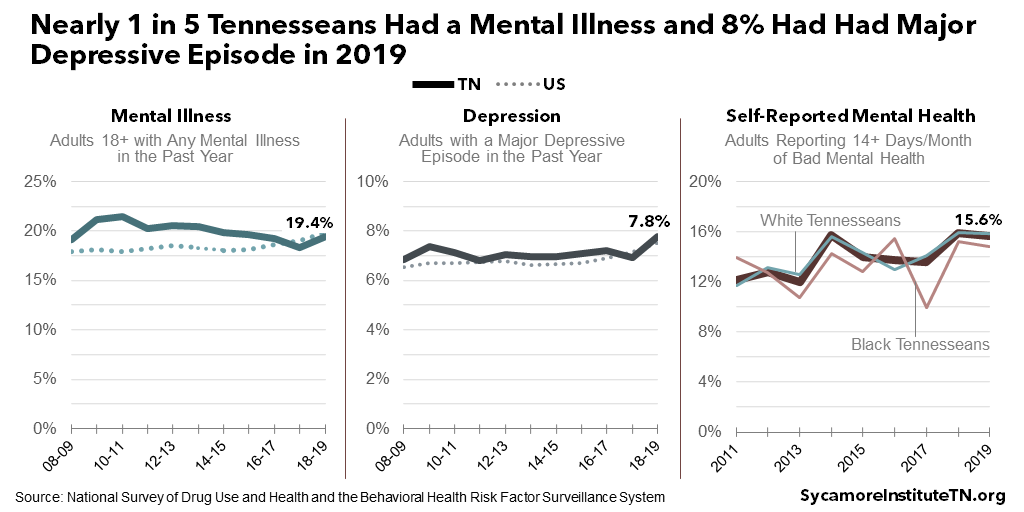
About one in 20 Tennessee adults had serious suicidal thoughts in 2019 and over 1,200 died by suicide (Figure 4). The rise in both metrics outpaced national trends over the last decade. Tennessee’s suicide death rate was nearly 20% higher than the national rate and the 20th highest in the country. Within Tennessee, whites were much more likely to die by suicide than black residents (Figure 4) – as were those in more rural parts of the state (Figure 5). Suicide rates were lowest among youth and highest among Tennesseans ages 35-44 and 75-84 (Figure 6).
Figure 4
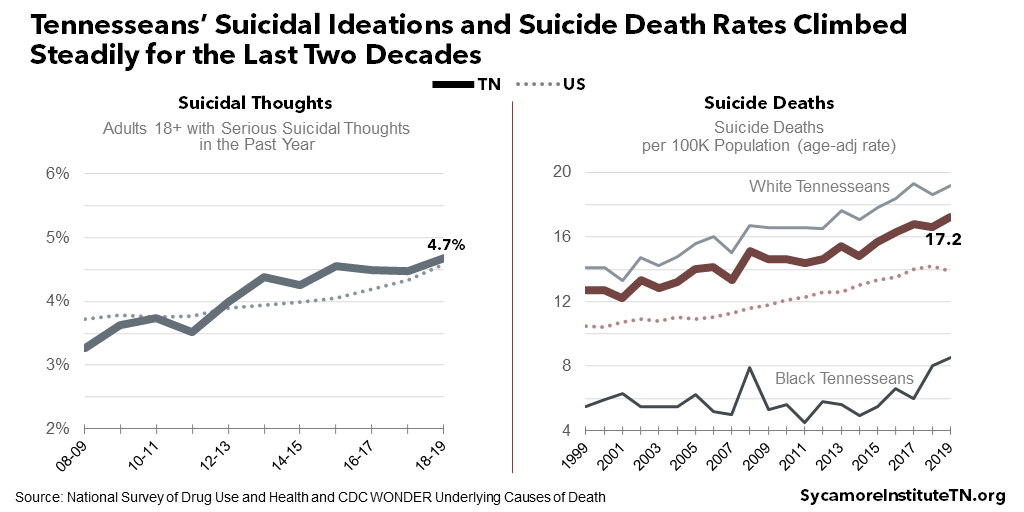
Figure 5
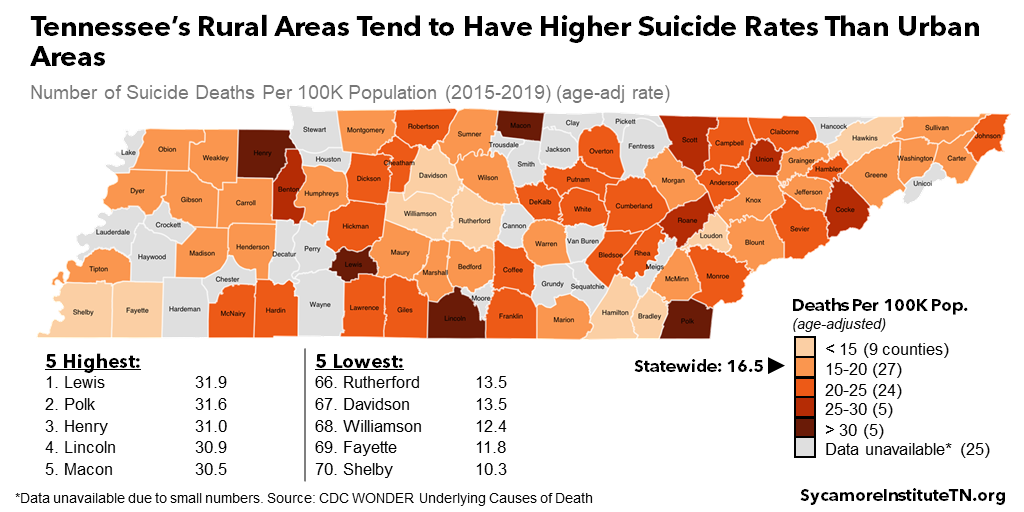
Figure 6
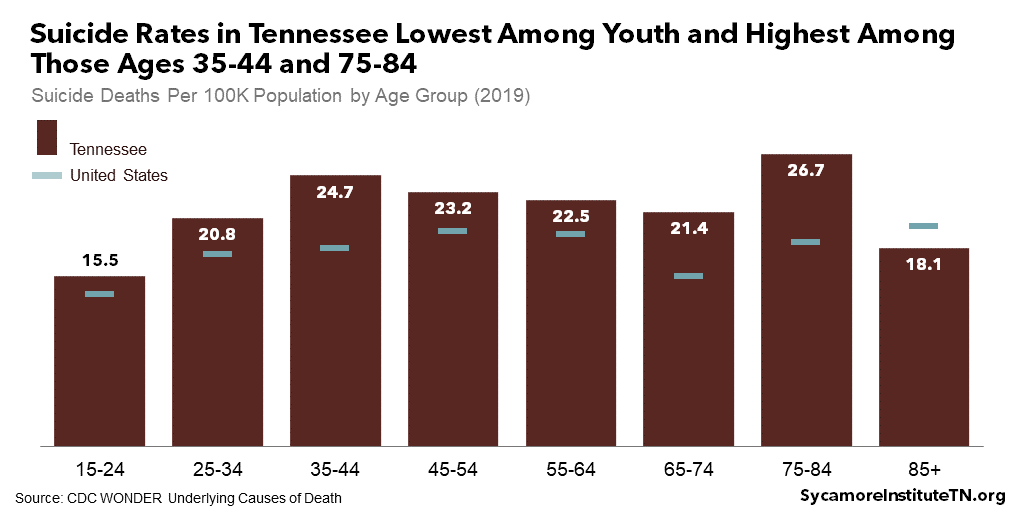
More children, teens, and young adults in Tennessee also reported mental health issues in recent years than in the past. In 2019, nearly two out of five Tennessee high school students reported feeling sad or hopeless almost every day, and suicide deaths reached historic highs for ages 15-24 (Figures 7 and 8). (10) (7) An estimated one in five high-schoolers in the state seriously considered suicide in 2019, and one in ten actually attempted it. In total, 135 teens and young adults ages 15-24 died from suicide that year – making it their second leading cause of death. Meanwhile, as of 2019, nearly 16% of Tennessee children and teens had a diagnosed mental or behavioral condition (e.g. conduct problems, anxiety) – compared with 13% nationally. (12)
Figure 7
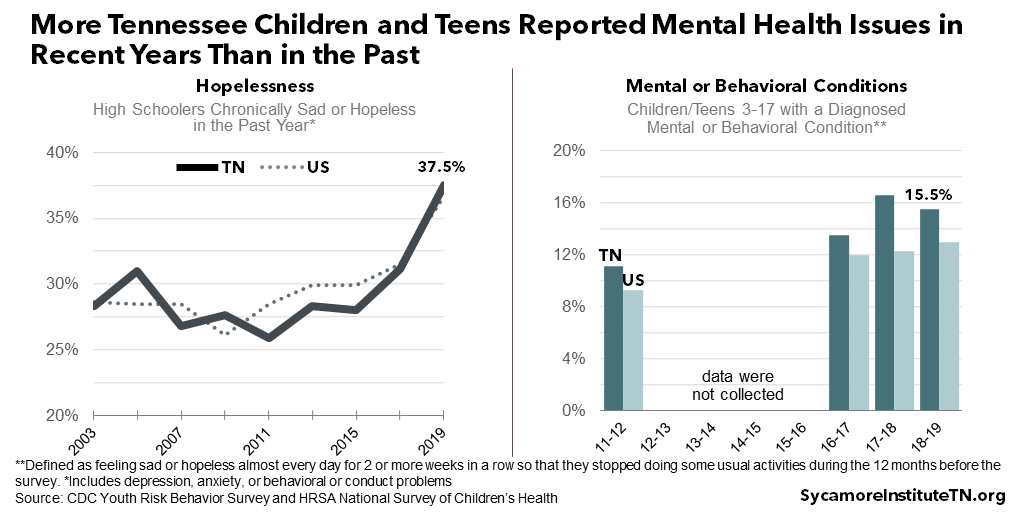
Figure 8
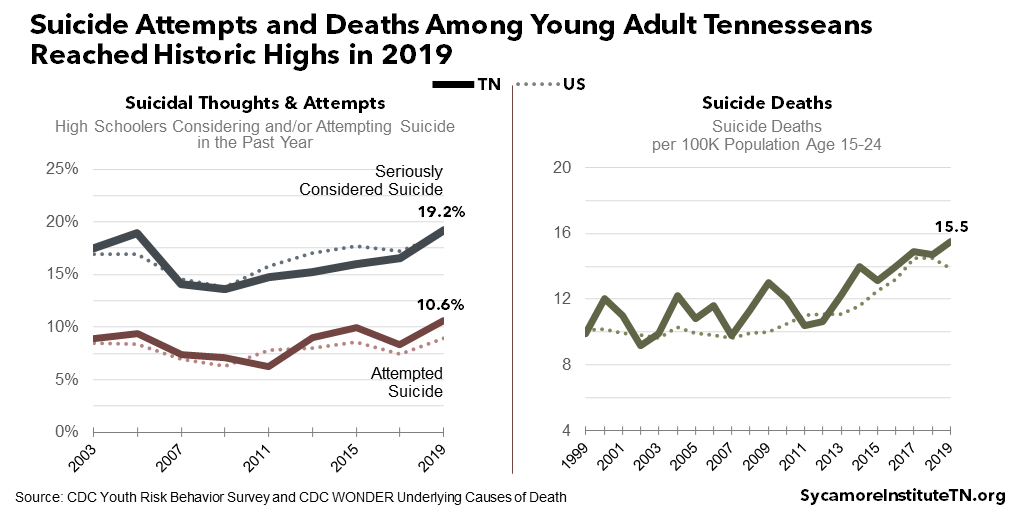
Drug Use in Tennessee Before the Pandemic
All Tennesseans
An estimated 11% of Tennessee adults used an illicit drug in the past month – including 3.2% for drugs other than marijuana – according to the most recent National Survey on Drug Use and Health (Figure 9). Tennesseans used marijuana or misused opioid prescriptions more than any other drugs (Figure 10). With the exception of methamphetamine, however, drug use was less common in Tennessee than in other states. (8)
Figure 9
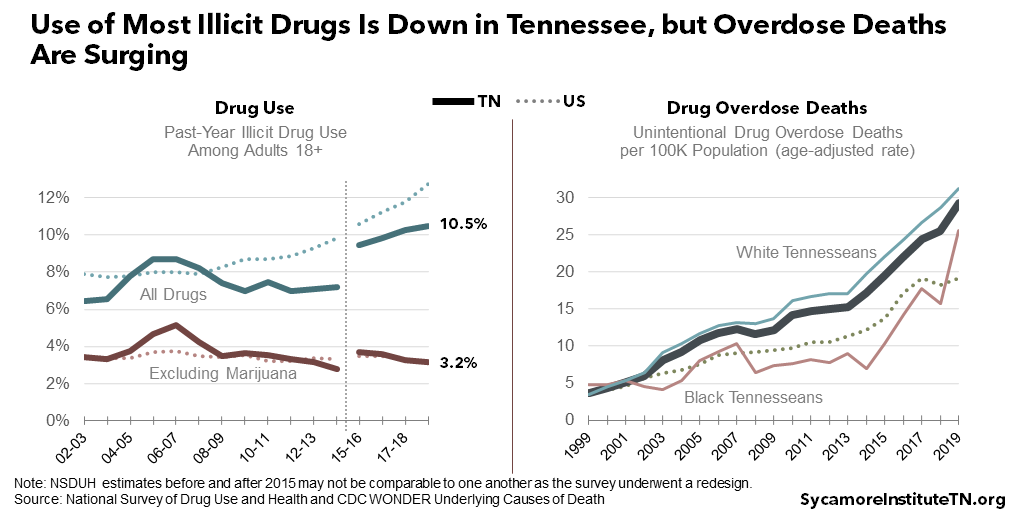
Figure 10
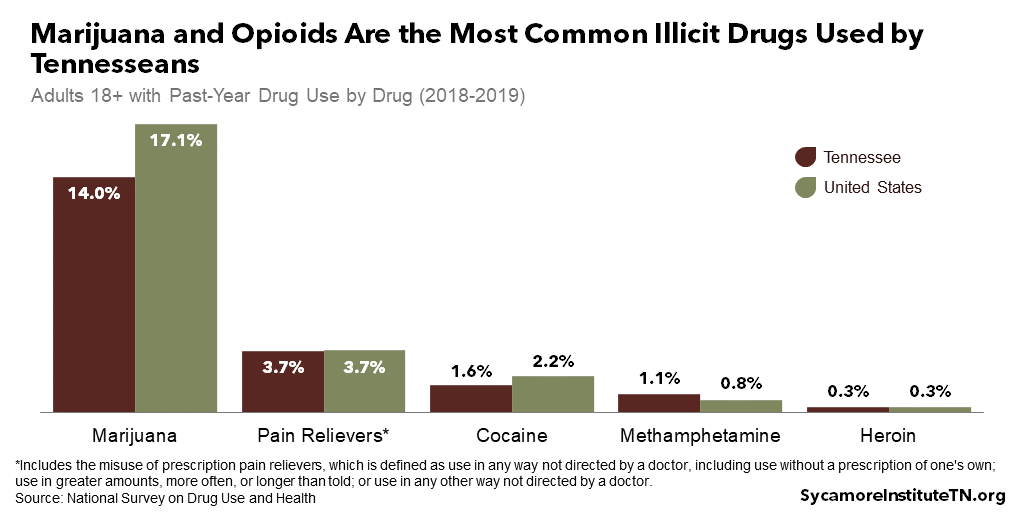
More Tennesseans reported using marijuana and methamphetamine in 2019 than in recent years, but the use of other illicit drugs has declined (Figure 11). Tennessee’s estimated rates of illicit drug use disorder have remained relatively stable at about 3% over the last two decades. (8) The share of Tennesseans age 18+ who had used marijuana in the past year rose steadily since 2012 to about 14% in 2019. Meanwhile, the misuse of pain relievers declined since the mid-2000s, cocaine and heroin remained relatively stable, and meth increased substantially (Figure 11).
Figure 11
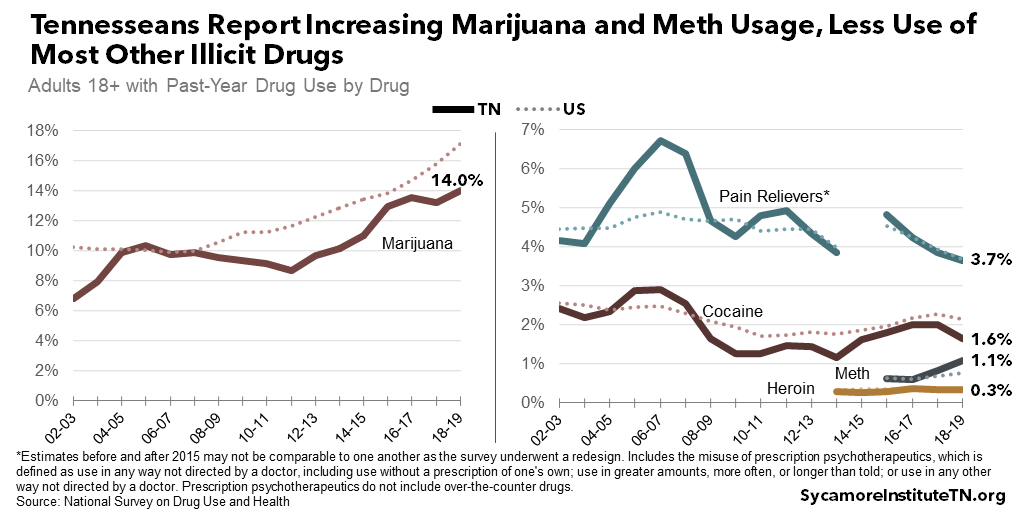
Overdose Deaths
Tennessee’s unintentional drug overdose deaths reached an all-time high in 2019 to claim almost 2,000 lives (Figure 10). The state’s rate was 53% above than the national rate that year and the 10th highest in the country. Tennesseans ages 25-54 had the highest rates of overdose deaths (Figure 12).
County-level unintentional drug overdose death rates across the state vary by a factor of five, with the highest rates largely concentrated in East Tennessee (Figure 13). Between 2015-2019, Cheatham County had the highest drug overdose death rate at nearly 51 deaths per 100,000 people – five times higher than Madison County on the low end. (7) Data were not available for 29 counties with very few people and/or overdose deaths.
Figure 12
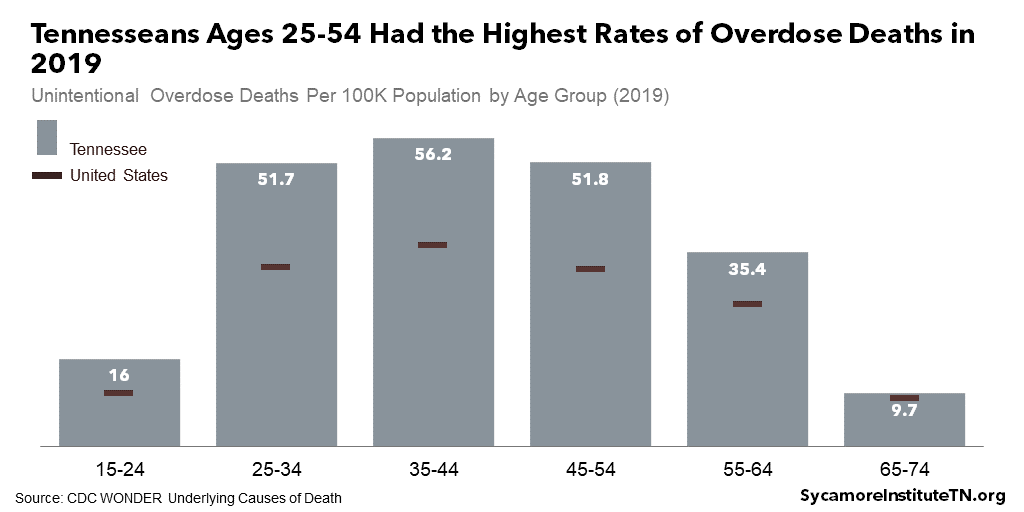
Figure 13
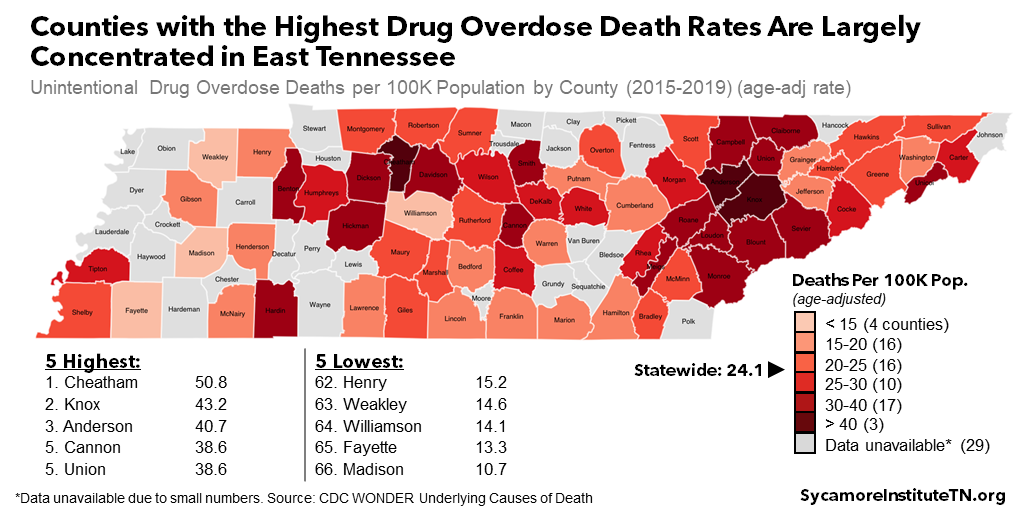
Racial disparities in unintentional overdose deaths narrowed since the early 2000s as mortality rates among black Tennesseans increased sharply (Figure 9). Black Tennesseans remained less likely to die from a drug overdose than white Tennesseans in 2019, but the gap is closing fast. Since 2014, for example, the rate of drug overdose among black residents rose by over 270% compared with about 58% for white residents. (7)
Fentanyl and heroin drove Tennessee’s rapid increase in drug overdose deaths in recent years (Figure 14). Two decades ago, synthetic opioids like fentanyl were involved in about 4% of all drug overdose deaths in Tennessee and heroin in less than 2%. By 2019, they were involved in nearly 60% and 20%, respectively. At the same time these began to spike, deaths involving prescription opioids declined sharply. (13) These data suggest that as the supply of prescription opioids declined, people who had grown dependent turned to more lethal alternatives.
Figure 14
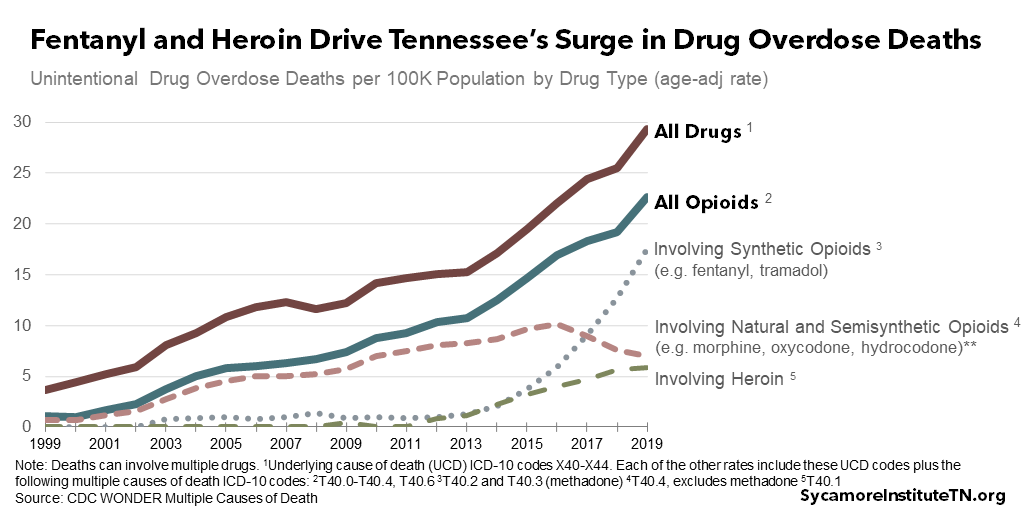
Teens and Young Adults
Marijuana and prescription pain relievers were the most commonly-used drugs by Tennessee high school students in 2019, but on the whole, teen drug use was historically low (Figure 15). Almost 18% used marijuana and nearly 14% had tried prescription pain relievers in 2019. Historical data for opioid use is not available, but marijuana use had fallen four percentage points in just six years. The share that had ever tried heroin was down two points from 2013, and historically low rates said they had ever tried cocaine or meth. (10) The state’s own survey of 8th, 10th, and 12th graders found lower rates of marijuana and prescription drug use in 2018-2019 – 11% and 9%, respectively – but historical and national data are not available for comparison. (14)
Despite promising trends in teen drug use, unintentional overdose deaths among Tennesseans ages 15-24 also reached an all-time high in 2019 (Figure 16). Rates of youth overdose deaths nationally and in Tennessee were similar until about 2016 when Tennessee’s rates began to rapidly increase (with a drop in 2018). All told, 139 people ages 15-24 died from a drug overdose in Tennessee in 2019.
Figure 15
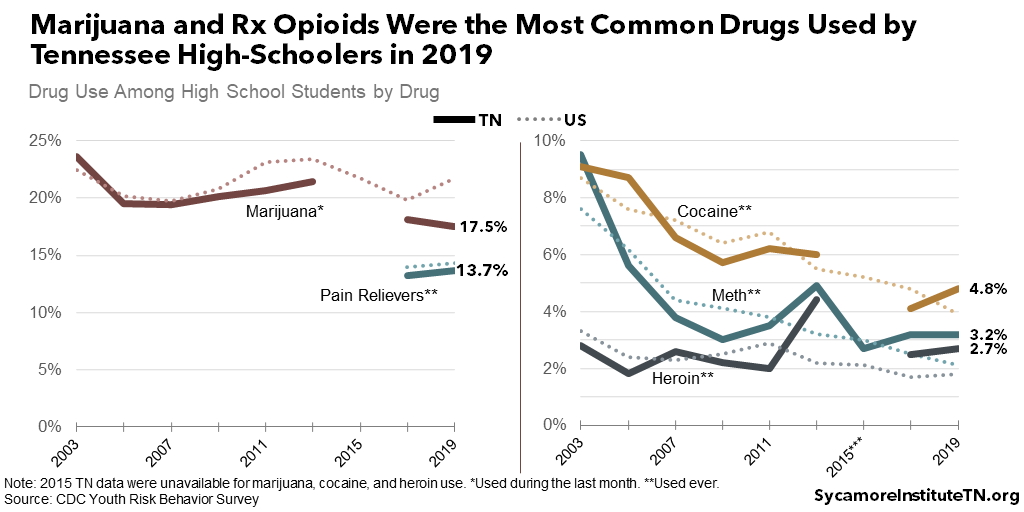
Figure 16
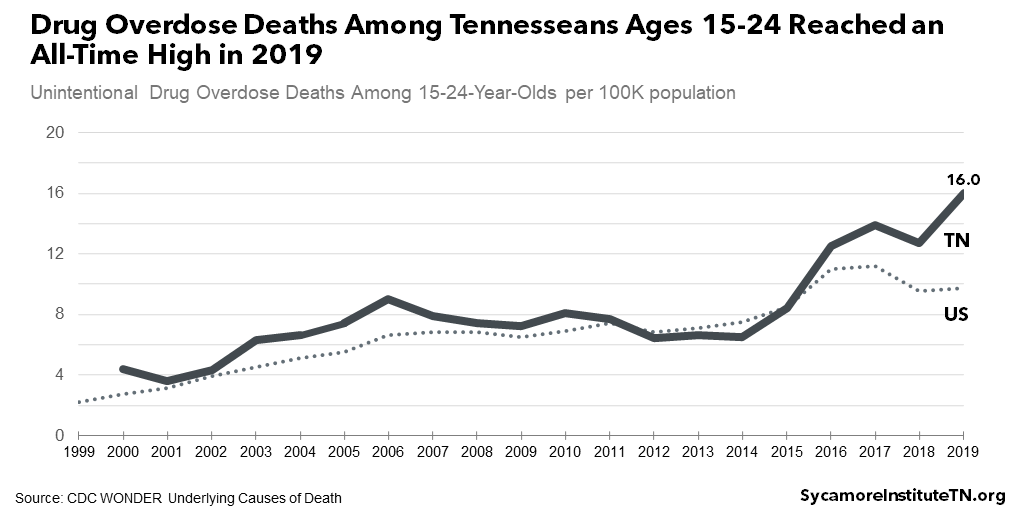
Alcohol Use in Tennessee Before the Pandemic
In 2019, an estimated 6% of Tennessee adults were heavy drinkers, and over 930 died from alcohol poisoning. While alcohol use disorder declined steadily from the late 2000s to 2018, heavy drinking and alcohol-induced deaths grew faster than national trends for much of the last decade (Figure 17). Within Tennessee, alcohol-induced deaths are most common in the middle and eastern parts of the state (Figure 18) and among adults ages 55-64 (Figure 19).
Figure 17
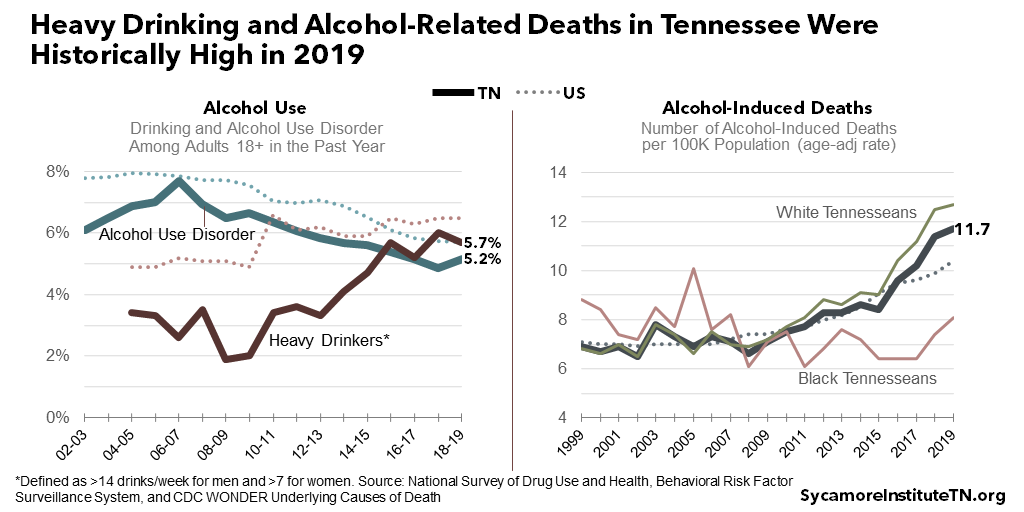
Figure 18
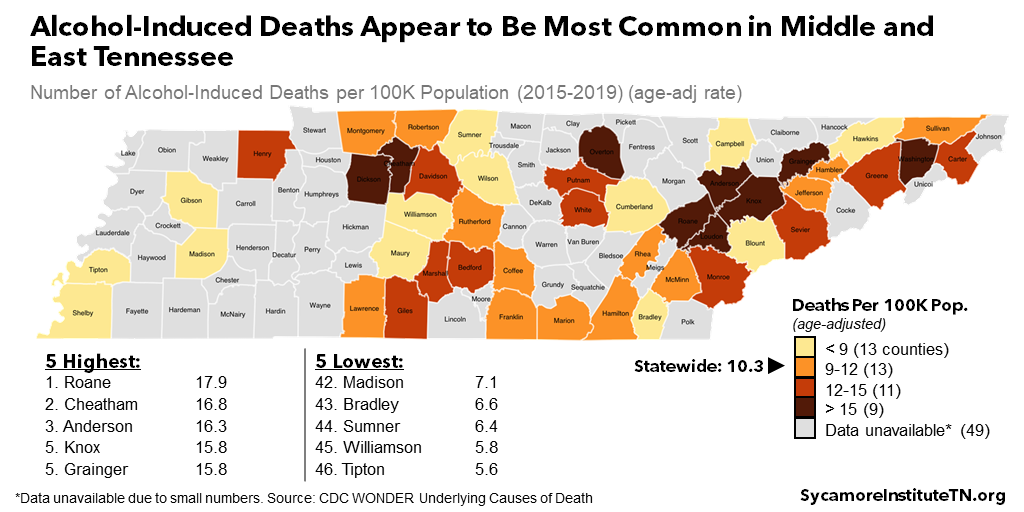
Figure 19
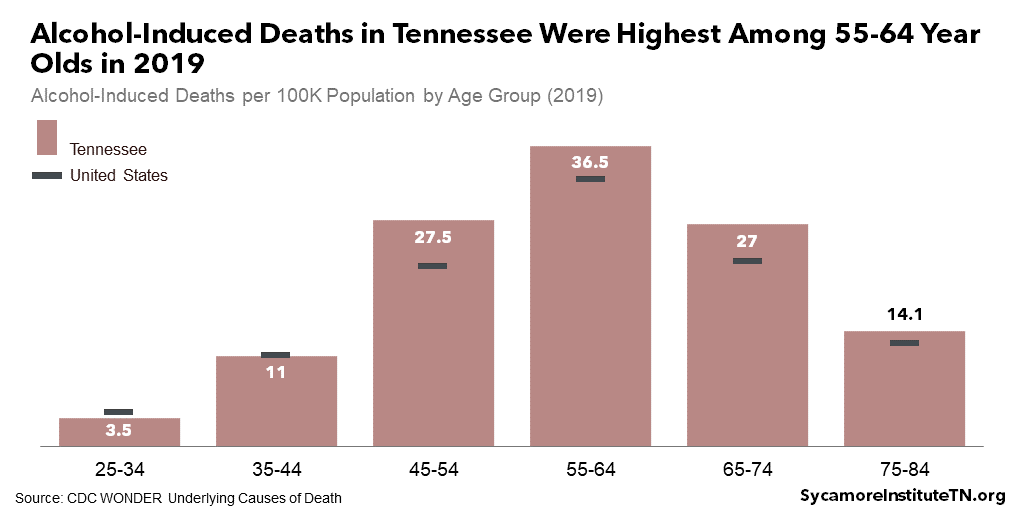
While adult drinking is on the rise, drinking among teenagers dropped precipitously over the last decade and a half. In 2015, 42% of Tennessee high school students reported drinking alcohol at least one day in the last month. By 2019, it had dropped to just under 22% – about a quarter less than the national rate (Figure 20). In 2019, about 9% of Tennessee high-schoolers reported binge drinking (defined as four or more drinks within a couple of hours for females and five for males) – compared to 14% nationally. (10) The state’s own survey of 8th, 10th, and 12th graders found lower rates of drinking in 2018-2019 – 17% in the past days – but historical and national data are not available for comparison. (14)
Figure 20
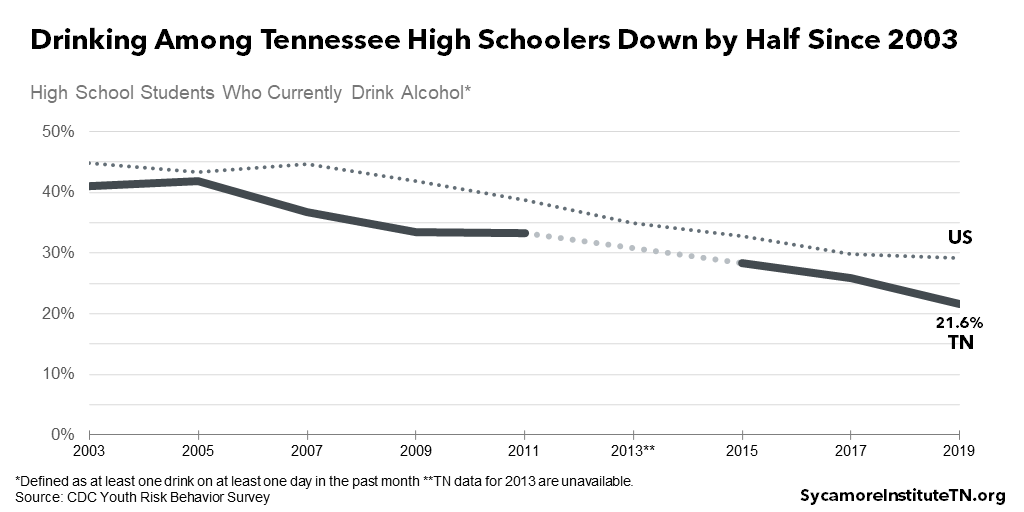
Access to Behavioral Health Care in Tennessee
Available measures suggest that more than half of children and adults with behavioral health needs in Tennessee do not receive treatment (Figure 21). In survey data from recent years, 52% of Tennessee adults with a mental illness, 57% of children diagnosed with mental and behavioral health conditions, and 83% of adults with drug treatment needs said they had not received care in the prior year. (15) (12)
Figure 21
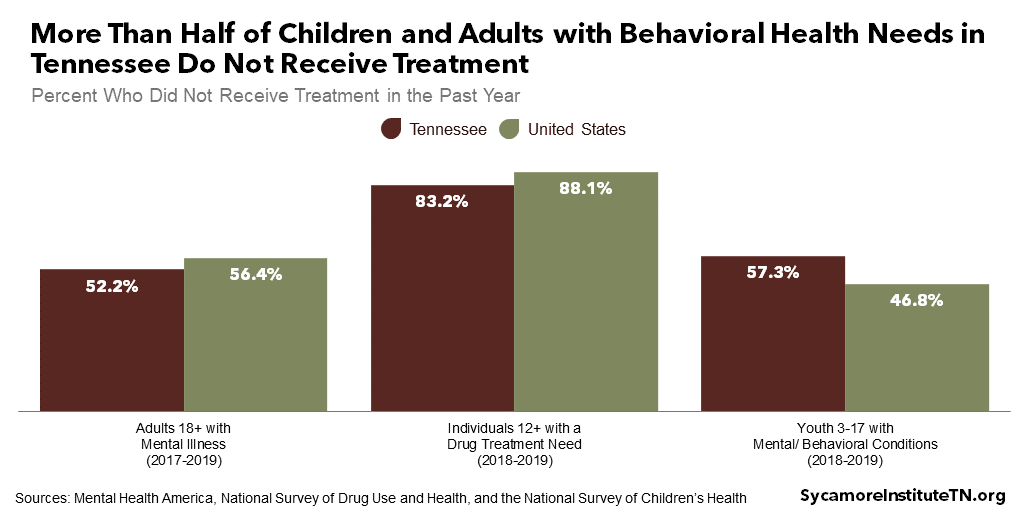
Provider availability may contribute to high rates of unmet need. Tennessee recently expanded its safety net for uninsured adults with behavioral health needs, but those services target only about 11% of people with serious mental illness and substance use disorder. The rest rely on private providers, where access may not match needs. (19) (20) (21) For example, Tennesseans have less access to mental health care providers than other Americans and experience stark urban-rural differences within the state (Figure 22). (17) (18) Prior studies and recent data suggest opioid abuse treatment capacity across the state and local opioid addiction and overdose rates do not always align. (22) For example, access to medication-assisted treatment varies considerably even among counties with both the lowest and highest opioid overdose rates (Figures 23). (23) (24) (13) (25) (22)
Figure 22
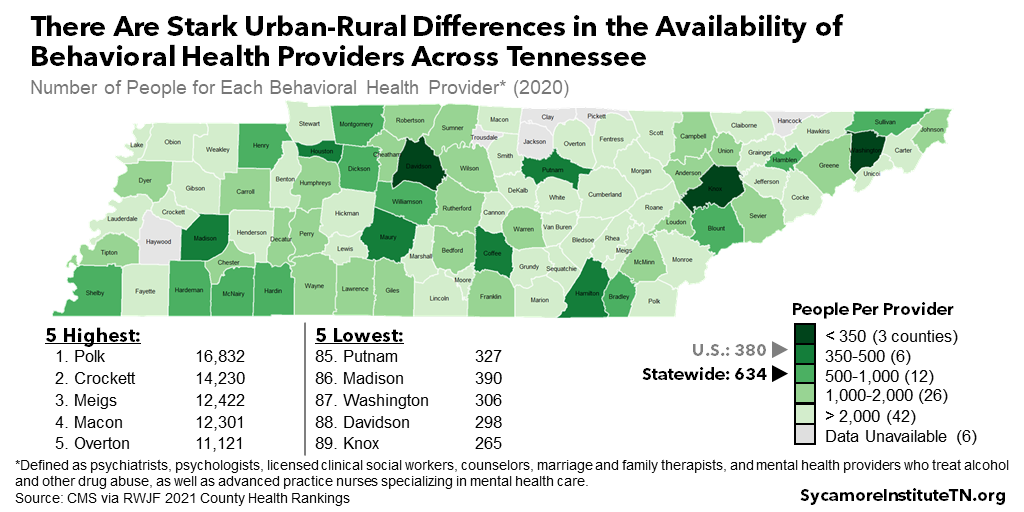
Figure 23
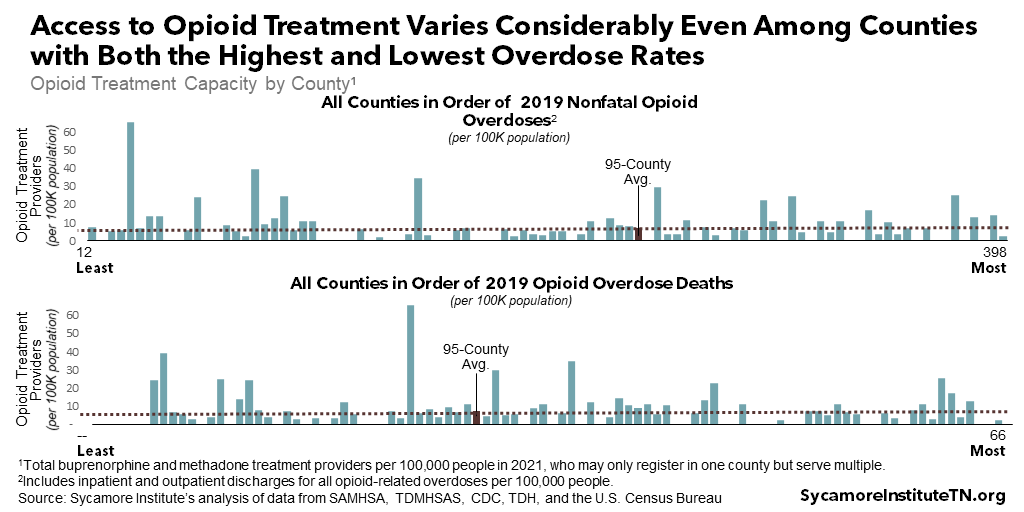
Measuring access to behavioral health care is tricky. The concept of “access” to health care of any kind can be complicated – ranging from affordability to provider availability to timeliness of care. Furthermore, people with untreated mental health or substance abuse issues may not acknowledge a need for treatment nor seek it out due to stigma or fear of discrimination. (27) (28) (29) The demand (or lack thereof) for services, in turn, affects the supply of providers. Together, these complexities pose challenges for measuring whether there is adequate access to treatment.
How the Pandemic Is Affecting Behavioral Health
Available data suggest that mental health and substance use disorder (SUD) needs have increased during the pandemic while access to care has decreased.
Behavioral Health Needs During the Pandemic
The COVID-19 pandemic’s swift and widespread health, economic, and social effects have generated significant stress. In the early months of the pandemic, more than a quarter of adults across the country reported being worried about the health of their family and loved ones, feeling isolated and alone, getting sick from COVID-19, and/or the losing their job or income. (30)
Mental Health Tracked COVID Hospitalizations
Stress related to the pandemic has negatively influenced Tennesseans’ mental health, according to available data. Adult Tennesseans reported peak levels of anxiety (Figure 24) and depression (Figure 25) symptoms in June 2020 and January 2021. (31) These rates were strongly correlated with trends in new COVID-related hospitalizations in Tennessee the week prior. (31) (32) Nationwide, rates of anxiety and depression symptoms more than tripled from pre-pandemic levels at certain points in the last 18 months. (33) (34) (35) Symptoms were especially common among parents, children in virtual schooling and their parents, family caregivers, health care and public health workers, and Hispanic adults. (36) (37) (30) (38)
Figure 24
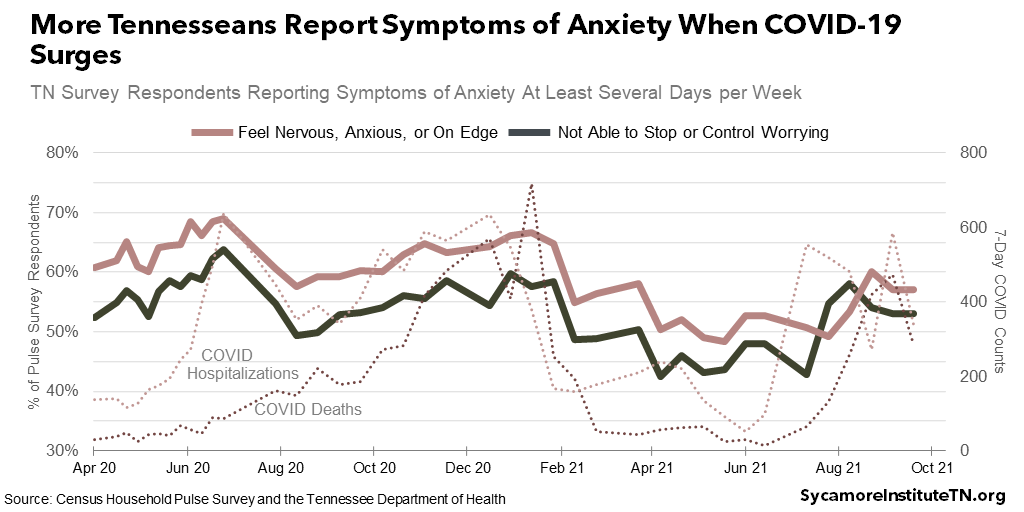
Figure 25
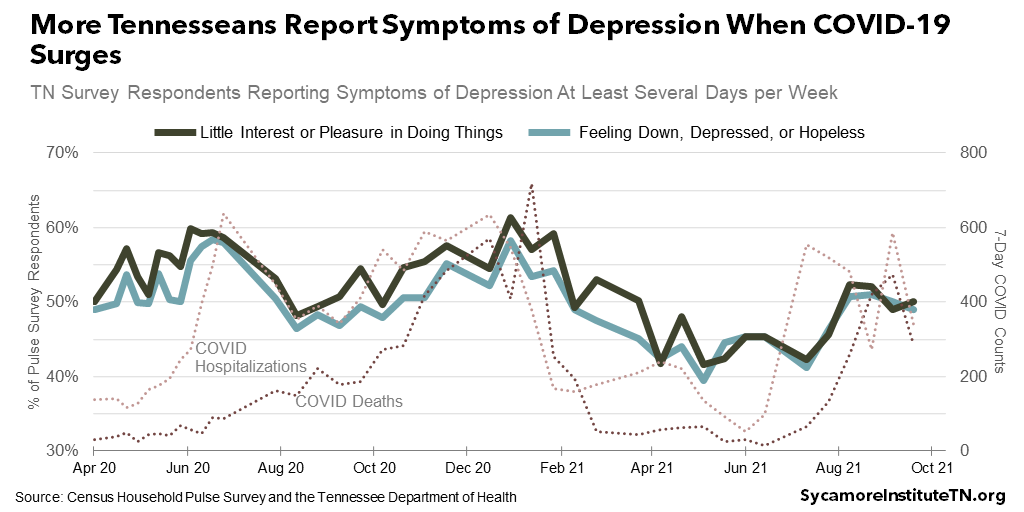
Early studies show the pandemic did not exacerbate overall suicide rates in the U.S. in 2020, but the decline may mask increases among some demographic groups. (39) (40) (41) (42) (43) For example, studies have found increases in suicide among black individuals in Maryland and in mental health emergency department visits for youth and young adults across the country. (44) (45) (46) It may also be too early to know the long-term effects. Experiences from past pandemics and disasters show suicide rates often decline initially but tick back up in the aftermath for reasons that researchers do not fully understand. (47) (48) (49)
Sharp Rise in Drug Overdoses
Tennessee’s unintentional drug overdoses increased dramatically during the pandemic. Over 3,000 Tennesseans died from a drug overdose in 2020 – a 44% increase over the prior year (Figure 26), compared with 29% nationally. Statewide, all but three of Tennessee’s 95 counties had at least one overdose death, and cases more than doubled in 21 counties (Figure 27). More than 2,000 of the statewide overdose deaths involved a synthetic opioid like fentanyl – an 85% annual increase compared with 55% nationally. (50) (51) (26) Meanwhile, non-fatal opioid overdose hospitalizations were 24% higher in March-December 2020 compared to the same period a year earlier. They were particularly high during the first six months of the pandemic (Figure 28). (52)
Figure 26
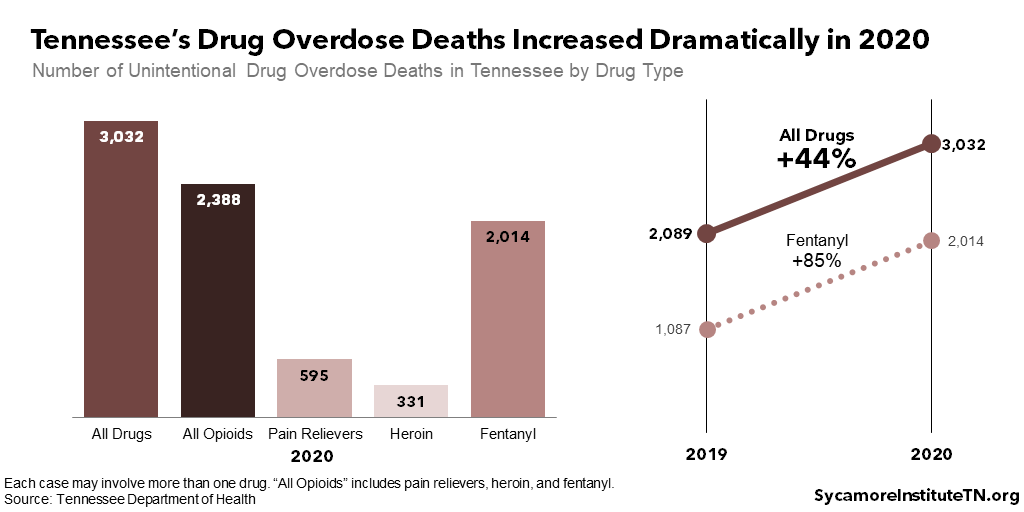
Figure 27
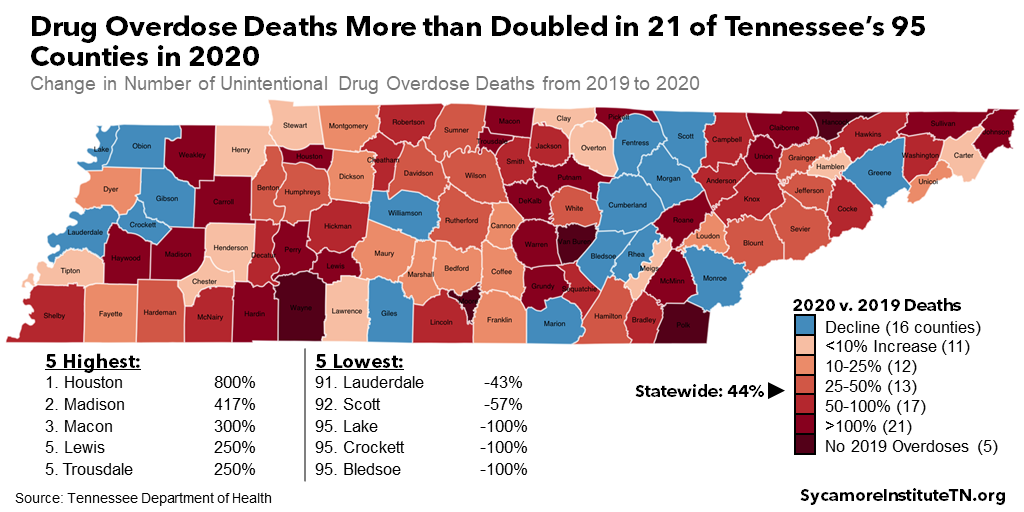
Figure 28
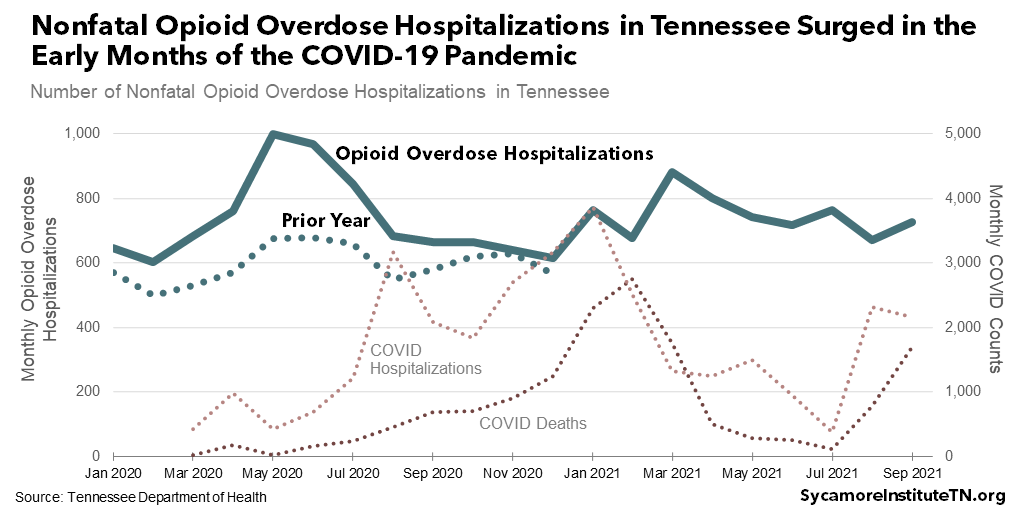
Alcohol Intake Surged
Evidence also points to surges in alcohol consumption during the pandemic. Recent studies found that Americans drank more heavily and more often during the pandemic than before. These trends were more pronounced among those with depression and anxiety and those who reported COVID-related stress, women, younger adults, and those subject to stay-at-home orders. (53) (54) (55) (56) (57)
Access to Behavioral Health Care During the Pandemic
Overall, the COVID-19 pandemic reduced access to and use of behavioral health services across the country. National surveys of private behavioral health care providers found that many closed programs, laid off or furloughed employees, decreased staff hours, and/or canceled patient appointments – usually in an effort to mitigate the spread of COVID-19. Patients also forwent many appointments, which contributed to the provider cutbacks. (33) The result was an overall increase in Americans’ self-reported unmet behavioral health care needs. (35)
However, the availability of telehealth services for behavioral health needs has increased. To mitigate the spread of COVID-19, health care providers, policymakers, and insurance plans took steps that quickly expanded the use of telehealth across many service areas. (58) The use of telehealth has been particularly high for psychiatry and SUD treatment. (59)
Parting Words
Even before COVID-19, many Tennesseans lived with mental health and substance use issues that contributed to elevated rates of suicide, drug overdose, and alcohol-induced death. The pandemic and its health, economic, and social consequences generally increased these challenges while limiting access to care. Deciding how best to allocate new funding will require a careful consideration of both Tennesseans’ needs and the state’s current capacity for prevention and treatment.
References
Click to Open/Close
- U.S. Congress. American Rescue Plan – Sec. 2701-2702. [Online] March 11, 2021. https://www.congress.gov/117/bills/hr1319/BILLS-117hr1319enr.pdf.
- U.S. Substance Abuse and Mental Health Services Administration (SAMHSA). FY 2021 Community Mental Health Block Grant Program American Rescue Plan Supplemental Awards. [Online] May 18, 2021. https://www.samhsa.gov/grants/block-grants/mhbg-american-rescue-plan.
- —. Tennessee – Summaries FY 2021. [Online] [Cited: September 17, 2021.] https://www.samhsa.gov/grants-awards-by-state/TN/2021.
- —. FY 2021 Substance Abuse Prevention and Treatment Block Grant Program American Rescue Plan Supplemental Awards. [Online] May 18, 2021. https://www.samhsa.gov/grants/block-grants/sabg-american-rescue-plan.
- Tennessee Department of Finance & Administration. Financial Stimulus Accountability Group. [Online] Available from https://www.tn.gov/finance/looking-for/stimulus-financial-accountability-group.html.
- U.S. Department of Treasury. Interim Final Rule: Coronavirus State and Local Fiscal Recovery Funds (31 CFR Part 35). [Online] May 2021. https://home.treasury.gov/system/files/136/FRF-Interim-Final-Rule.pdf.
- U.S. Centers for Disease Control and Prevention (CDC). Underlying Causes of Death 1999-2019 on CDC WONDER Online Database. National Center for Health Statistics. [Online] 2020. [Cited: May 25, 2021.] Accessed from http://wonder.cdc.gov/ucd-icd10.html.
- U.S. Substance Abuse and Mental Health Services Administration (SAMHSA). National Survey on Drug Use and Health (NSDUH). Substance Abuse and Mental Health Data Archive. [Online] [Cited: May 26, 2021.] Accessed via https://pdas.samhsa.gov/saes/state.
- U.S. Centers for Disease Control and Prevention (CDC). Behavioral Risk Factor Surveillance System. [Online] 2012-2020. Data accessed via https://www.cdc.gov/brfss/brfssprevalence/index.html and https://nccd.cdc.gov/weat/#/crossTabulation/selectYear.
- —. 1991-2019 High School Youth Risk Behavior Survey. [Online] [Cited: August 3, 2021.] Data accessed from http://nccd.cdc.gov/youthonline/.
- U.S. Substance Abuse and Mental Health Services Administration (SAMHSA). Appendix A: Key Definitions for the 2019 National Survey on Drug Use and Health. Results from the 2019 National Survey on Drug Use and Health: Detailed Tables. [Online] [Cited: September 7, 2021.] https://www.samhsa.gov/data/sites/default/files/reports/rpt29394/NSDUHDetailedTabs2019/NSDUHDetTabsAppA2019.htm.
- U.S. Health Resources and Services Administration (HRSA) and U.S. Centers for Disease Control and Prevention (CDC). National Surevey of Children’s Health. [Online] [Cited: August 3, 2021.] Data retrieved from the Child and Adolescent Health Measurement Initiative, Data Resource Center for Child and Adolescent Health via www.childhealthdata.org.
- U.S. Centers for Disease Control and Prevention (CDC). Multiple Causes of Death 1999-2019 on CDC WONDER Online Database. National Center for Health Statistics. [Online] 2020. [Cited: May 25, 2021.] Accessed from https://wonder.cdc.gov/mcd-icd10.html.
- Tennessee Department of Mental Health and Substance Abuse Services (TDMHSAS). TN Together Student Survey. [Online] 2020. https://www.tn.gov/behavioral-health/substance-abuse-services/prevention/tn-together-student-survey.html.
- Mental Health America. Access to Care Ranking 2020. [Online] 2021. [Cited: August 4, 2021.] https://mhanational.org/issues/2020/mental-health-america-access-care-data#four.
- U.S. Substance Abuse and Mental Health Services Administration (SAMHSA). National Survey on Drug Use and Health (2-Year Estimates) – Online Analysis Tool. [Online] 2020. [Cited: September 10, 2021.] Data accessed from https://rdas.samhsa.gov/#/.
- U.S. Centers for Medicare and Medicaid Services (CMS) via the Robert Wood Johnson Foundation. 2021 County Health Rankings: Mental Health Providers. [Online] 2021. https://www.countyhealthrankings.org/app/tennessee/2021/measure/factors/62/map.
- Robert Wood Johnson. 2021 County Health Rankings: Rankings and Documentation. [Online] 2021. [Cited: August 4, 2021.] https://www.countyhealthrankings.org/explore-health-rankings/rankings-data-documentation.
- U.S. Substance Abuse and Mental Health Services Administration (SAMHSA). Uniform Reporting System. [Online] [Cited: November 1, 2021.] https://www.samhsa.gov/data/all-reports?f%5B0%5D=location%3A247&f%5B1%5D=report_type%3A367&f%5B2%5D=survey_type%3A389.
- Tennessee Department of Mental Health and Substance Abuse Services (TDMHSAS). FY 2023 Governor’s Budget Hearing . [Online] November 1, 2021. Video available from https://sts.streamingvideo.tn.gov/Mediasite/Channel/mediasiteadmin-tn-budget-hearingsfy2022-2023/watch/84b65d73716a4266b4589288a3519cc61d.
- Tennessee Department of Health. 2020 Uninsured Adult Healthcare Safety Net Annual Report. [Online] 2021. https://www.tn.gov/content/dam/tn/health/program-areas/reports_and_publications/Safety_Net_Report_FY20.pdf.
- Tennessee Department of Mental Health and Substance Abuse Services (TDMHSAS). Emerging Trends in Prescribing Buprenorphine: Tennessee 2015-2016. [Online] February 15, 2017. https://www.tn.gov/content/dam/tn/mentalhealth/documents/Tennessee_BuprenorphineTrends_2015-2016.pdf.
- U.S. Substance Abuse and Mental Health Services Administration (SAMHSA). Buprenorphine Practitioner Locator. [Online] [Cited: September 8, 2021.] https://www.samhsa.gov/medication-assisted-treatment/practitioner-program-data/treatment-practitioner-locator?field_bup_state_value=50.
- Tennessee Department of Mental Health and Substance Abuse Services (TDMHSAS). Tennessee Opioid Treatment Clinics. [Online] April 20, 2021. [Cited: September 8, 2021.] https://www.tn.gov/content/dam/tn/mentalhealth/documents/TN_OTP_Map-4-20-21.pdf
- U.S. Census Bureau. Annual Estimates of the Resident Population for Counties: April 1, 2010 to July 1, 2019. [Online] April 20, 2021. https://www.census.gov/data/tables/time-series/demo/popest/2010s-counties-total.html
- Tennessee Department of Health. Tennessee Drug Overdose Dashboard. [Online] [Cited: September 17, 2021.] https://www.tn.gov/health/health-program-areas/pdo/pdo/data-dashboard.html
- National Academies of Science, Engineering, and Medicine. Chapter 2 – Understanding Stigma of Mental and Substance Use Disorders . Ending Discrimination Against People with Mental and Substance Use Disorders: The Evidence for Stigma Change. [Online] August 3, 2016. https://www.ncbi.nlm.nih.gov/books/NBK384923/
- American Psychiatric Association. Stigma, Prejudice and Discrimination Against People with Mental Illness. [Online] [Cited: September 7, 2021.] https://www.psychiatry.org/patients-families/stigma-and-discrimination
- Corrigan, Patrick W., Druss, Benjamin G. and Perlick, Deborah A. The Impact of Mental Illness Stigma on Seeking and Participating in Mental Health Care. Psychological Science in the Public Interest. [Online] September 3, 2014. https://doi.org/10.1177%2F1529100614531398
- McKnight-Eily, Lela, et al. Racial and Ethnic Disparities in the Prevalence of Stress and Worry, Mental Health Conditions, and Increased Substance Use Among Adults During the COVID-19 Pandemic — United States, April and May 2020. Morbidity and Mortality Weekly Report (MMWR), U.S. Centers for Disease Control and Prevention (CDC). [Online] February 5, 2021. https://www.cdc.gov/mmwr/volumes/70/wr/mm7005a3.htm?s_cid=mm7005a3_w
- U.S. Census Bureau. Household Pulse Survey. [Online] [Cited: November 1, 2021.] Data retrieved from https://www.census.gov/programs-surveys/household-pulse-survey/data.html
- The Sycamore Institute’s analysis of data from the Tennessee Department of Health. [Online] November 1, 2021. Data retrieved from https://www.tn.gov/health/cedep/ncov/data/downloadable-datasets.html
- U.S. Government Accountability Office (GAO). Behavioral Health: Patient Access, Provider Claims Payment, and the Effect of the COVID-19 Pandemic. [Online] March 31, 2021. https://www.gao.gov/assets/gao-21-437r.pdf
- U.S. Centers for Disease Control and Prevention (CDC). Early Release of Selected Mental Health Estimates Based on Data from the January–June 2019 National Health Interview Survey . National Center for Health Statistics. [Online] May 2020. https://www.cdc.gov/nchs/data/nhis/earlyrelease/ERmentalhealth-508.pdf
- Vahratian, Anjel, et al. Symptoms of Anxiety or Depressive Disorder and Use of Mental Health Care Among Adults During the COVID-19 Pandemic — United States, August 2020–February 2021. Morbidity and Mortality Weekly Report (MMWR), U.S. Centers for Disease Control and Prevention (CDC). [Online] April 2, 2021. https://www.cdc.gov/mmwr/volumes/70/wr/mm7013e2.htm?s_cid=mm7013e2_w
- Bryant-Genevier, Jonathan, et al. Symptoms of Depression, Anxiety, Post-Traumatic Stress Disorder, and Suicidal Ideation Among State, Tribal, Local, and Territorial Public Health Workers During the COVID-19 Pandemic — United States, March–April 2021. Morbidity and Mortality Weekly Report (MMWR), U.S. Centers for Disease Control and Prevention (CDC). [Online] June 2, 2021. https://www.cdc.gov/mmwr/volumes/70/wr/mm7026e1.htm?s_cid=mm7026e1_w
- Czeisler, Mark, et al. Mental Health Among Parents of Children Aged <18 Years and Unpaid Caregivers of Adults During the COVID-19 Pandemic — United States, December 2020 and February–March 2021. Morbidity and Mortality Weekly Report (MMWR), U.S. Centers for Disease Control and Prevention (CDC). [Online] June 18, 2021. https://www.cdc.gov/mmwr/volumes/70/wr/mm7024a3.htm?s_cid=mm7024a3_w
- Verlenden, Jorge, et al. Association of Children’s Mode of School Instruction with Child and Parent Experiences and Well-Being During the COVID-19 Pandemic — COVID Experiences Survey, United States, October 8–November 13, 2020. Morbidity and Mortality Weekly Report (MMWR), U.S. Centers for Disease Control and Prevention (CDC). [Online] March 19, 2021. https://www.cdc.gov/mmwr/volumes/70/wr/mm7011a1.htm?s_cid=mm7011a1_w
- Ahmad, Farida and Anderson, Robert. The Leading Causes of Death in the US for 2020. Journal of the American Medical Association (JAMA). [Online] March 31, 2021. https://jamanetwork.com/journals/jama/fullarticle/2778234
- Tandon, Rajiv. COVID-19 and Suicide: Just The Facts. Key Learnings and Guidance for Action. Asian Journal of Psychiatry. [Online] May 11, 2021. https://www.ncbi.nlm.nih.gov/pmc/articles/PMC8110323/
- Faust, Jeremy Samuel, Shah, Sejal B. and Du, Chengan. Suicide Deaths During the COVID-19 Stay-at-Home Advisory in Massachusetts, March to May 2020. Journal of the American Medical Association (JAMA). [Online] January 21, 2021. https://jamanetwork.com/journals/jamanetworkopen/fullarticle/2775359
- Faust, Jermey S, Du, Chengan and Mayes, Katherine Dickerson. Mortality From Drug Overdoses, Homicides, Unintentional Injuries, Motor Vehicle Crashes, and Suicides During the Pandemic, March-August 2020. Journal of American Medical Association (JAMA). [Online] May 21, 2021. https://jamanetwork.com/journals/jama/fullarticle/2780436
- Pirkis, Jane, et al. Suicide Trends in the Early Months of the COVID-19 Pandemic: An Interrupted Time-Series Analysis of Preliminary Data From 21 Countries. The Lancet Psychiatry. [Online] April 13, 2021. https://www.thelancet.com/journals/lanpsy/article/PIIS2215-0366(21)00091-2/fulltext
- Bray, Michael Johnathan Charles, Daneshvari, Nicholas Omid and Radhakrishnan, Indu. Racial Differences in Statewide Suicide Mortality Trends in Maryland During the Coronavirus Disease 2019 (COVID-19) Pandemic. JAMA Psychiatry. [Online] December 16, 2020. https://jamanetwork.com/journals/jamapsychiatry/fullarticle/2774107
- Holland, Kristin, Jones, Christopher and Vivolo-Kantor, Alana. Trends in US Emergency Department Visits for Mental Health, Overdose, and Violence Outcomes Before and During the COVID-19 Pandemic. JAMA Psychiatry. [Online] February 3, 2021. https://jamanetwork.com/journals/jamapsychiatry/fullarticle/2775991
- Yard, Ellen, et al. Emergency Department Visits for Suspected Suicide Attempts Among Persons Aged 12–25 Years Before and During the COVID-19 Pandemic — United States, January 2019–May 2021. Morbidity and Mortality Weekly Report (MMWR), U.S. Centers for Disease Control and Prevention (CDC). [Online] June 18, 2021. https://www.cdc.gov/mmwr/volumes/70/wr/mm7024e1.htm
- Moran, Mark. Suicides Drop During Past Year of Pandemic, Study Finds. Psychiatric News. [Online] https://psychnews.psychiatryonline.org/doi/10.1176/appi.pn.2021.6.15
- Liang, Angela and Nestadt, Paul. Suicide Risk in the COVID-19 Pandemic. Johns Hopkins Medicine Psychiatric Guide. [Online] February 13, 2021. https://www.hopkinsguides.com/hopkins/view/Johns_Hopkins_Psychiatry_Guide/787393/all/Suicide_Risk_in_the_COVID_19_Pandemic
- Appleby, Louis. What Has Been the Effect of Covid-19 on Suicide Rates? The BMJ. [Online] March 29, 2021. https://www.bmj.com/content/372/bmj.n834
- Tennessee Department of Health. 2020 Tennessee Drug Overdose Deaths. [Online] September 1, 2021. https://www.tn.gov/content/dam/tn/health/documents/pdo/2020_Tennessee_Drug_Overdose_Deaths.pdf
- U.S. Centers for Disease Control and Prevention (CDC). National Vital Statistics Rapid Release: Provisional Drug Overdose Death Counts through October 2020. National Center for Health Statistics. [Online] July 14, 2021. [Cited: July 29, 2021.] https://www.cdc.gov/nchs/nvss/vsrr/drug-overdose-data.htm
- Tennessee Department of Health. Monthly Hospital-Reported Nonfatal Opioid Overdose Reports. [Online] [Cited: November 1, 2021.] Accessed from https://www.tn.gov/health/health-program-areas/pdo/pdo/facts-figures.html
- Pollard, Michael S., Tucker, Joan S. and Green, Harold D. Changes in Adult Alcohol Use and Consequences During the COVID-19 Pandemic in the US. JAMA Open Network. [Online] September 29, 2020. https://jamanetwork.com/journals/jamanetworkopen/fullarticle/2770975
- Grossman, Elyse, Benjamin-Neelon, Sara and Sonnenschein, Susan. Alcohol Consumption During the COVID-19 Pandemic: A Cross-Sectional Survey of US Adults. International Journal of Environmental Research and Public Health. [Online] December 9, 2020. https://www.ncbi.nlm.nih.gov/pmc/articles/PMC7763183/
- Capasso, Ariadna, et al. Increased Alcohol Use During the COVID-19 Pandemic: The Effect of Mental Health and Age in a Cross-Sectional Sample of Social Media Users in the U.S. Preventive Medicine. [Online] April 2021. https://www.sciencedirect.com/science/article/abs/pii/S0091743521000062
- Killgore, William, et al. Alcohol Dependence During COVID-19 Lockdowns. Psychiatry Research. [Online] February 2021. https://www.sciencedirect.com/science/article/pii/S0165178120333370
- Barbosa, Carolina, Cowell, Alexander and Dowd, William. Alcohol Consumption in Response to the COVID-19 Pandemic in the United States. Journal of Addiction Medicine. [Online] July/August 2021. https://journals.lww.com/journaladdictionmedicine/Abstract/2021/08000/Alcohol_Consumption_in_Response_to_the_COVID_19.15.aspx
- Koma, Wyatt, Cubanski, Juliette and Neuman, Tricia. Medicare and Telehealth: Coverage and Use During the COVID-19 Pandemic and Options for the Future. Kaiser Family Foundation (KFF). [Online] May 19, 2021. https://www.kff.org/medicare/issue-brief/medicare-and-telehealth-coverage-and-use-during-the-covid-19-pandemic-and-options-for-the-future/
- Bestennyy, Oleg, et al. Telehealth: A Quarter-Trillion-Dollar Post-COVID-19 Reality? McKinsey & Company. [Online] July 9, 2021. https://www.mckinsey.com/industries/healthcare-systems-and-services/our-insights/telehealth-a-quarter-trillion-dollar-post-covid-19-reality

